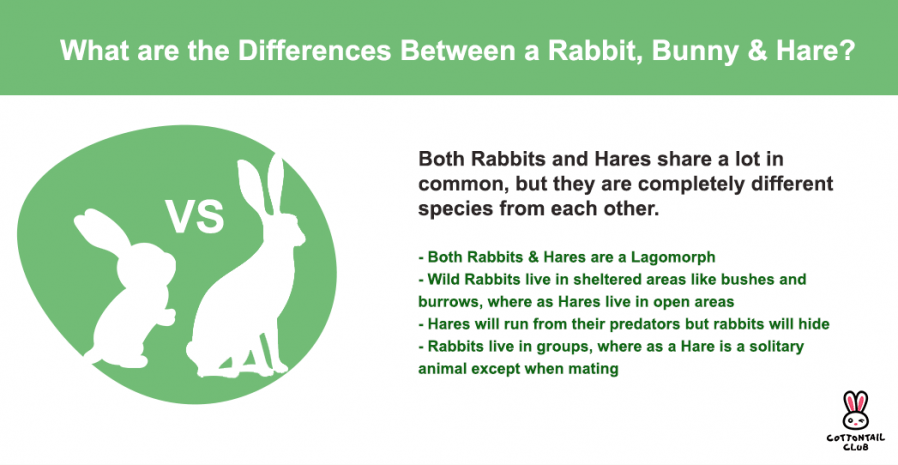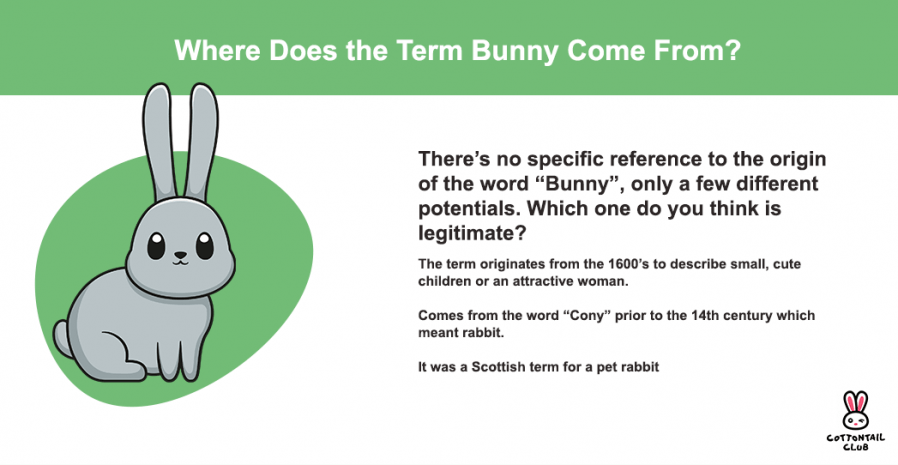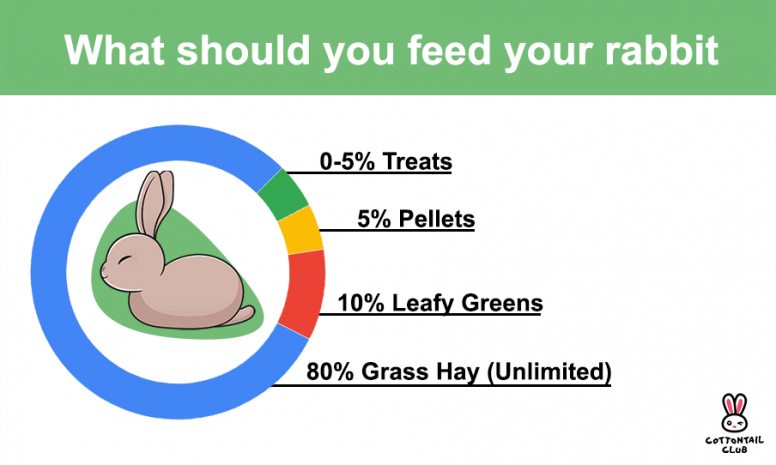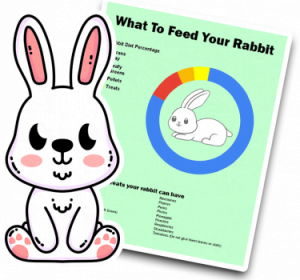
You’ll likely have heard of rabbits, bunnies, and hares. You might even own a rabbit or two! Sometimes these terms are used interchangeably, but did you know they mean very different things? Let’s take a closer look.

The word rabbit is the correct term for our furry little friends. It’s the scientific term used to describe around 30 species of rabbits, including the pet rabbits many of us have in our homes.
On the other hand, the word ‘bunny’ is a colloquial term, which means it’s used casually to describe rabbits. It doesn’t have any scientific basis. You might hear bunny used to refer to ‘baby rabbits’ or smaller rabbits. However, baby rabbits actually have a scientific name: they’re called kittens or kits.
Bunny is also used when people want a cuter name for rabbits. For example, you’ll have heard of the Easter bunny. You might hear it in children’s programs or in books. In some cases, it’s shortened to ‘bun’ or lengthened to ‘bunny rabbit’.
In the present, the word bunny can be used to refer to any rabbit. The terms bunny and rabbit can be used interchangeably, but when it comes to science, rabbit is the correct term!
So, if the word bunny isn’t the correct word for a rabbit, where did it come from? When you think about it, the two words don’t sound anything like each other! Well, there’s no definitive answer but there are a number of theories.
The first, and perhaps most promising theory, is that it came from the Scottish term ‘bun’. According to the Online Etymology Dictionary, from the 1680s in the Scots language ‘bun’ was used as a name for a pet rabbit.
In the 1600s, the terms ‘bun’ and ‘bunny’ were often used to describe a small, cute child or an attractive woman. It was also used to describe squirrels and rabbits. The term could have developed from there, especially since bunny is now often used to describe small and baby rabbits.
It may have come from the word ‘coney’ or ‘cony’ which was used before the 14th century as the word for a rabbit. This word gradually fell out of favor after the 14th century because people felt it sounded like a swear word. Some people feel that it may have been replaced with ‘bunny’ in later years because it sounded similar, although there isn’t much evidence of this. Fundamentally, we don’t know the exact origins of the word, although the theories are plausible and interesting.

Steven Lukefahr, a geneticist at Texas A&M University explains that rabbits and hares share a lot of similarities, but they’re actually different species! Let’s have a look at some more details.
The short answer is yes, a hare is a Lagomorph. A Lagomorph is a mammal under the order classification Lagomorpha, which is made up of hares, rabbits, and pikas (a small mountain-dwelling animal).
Scientists classify and separate plants and animals with a system of classification called ‘taxon’. They’re all arranged in a hierarchy ranging from kingdom down to subspecies. This just helps us to understand different species and how they’re related to one another.
The taxonomic categories are listed below:
Rabbits and hares are both under the same order, called Lagomorpha. They’re also under the same family, called Leporidae. However, they come under different genera. Hares are under the genus Lepus, while rabbits are found under ten different genera. They are both completely different species.
At first glance, rabbits and hares can look similar, but there are actually a lot of differences in their anatomy. In most cases, hares are larger than rabbits. Hares have longer ears than rabbits with black tips and they have longer legs than most rabbits. Hares can also have larger heads than rabbits, depending on the species.
Both hares and rabbits molt, meaning they shed their coat. However, hares can change their coat color quite dramatically depending on the seasons. An excellent example of this is the snowshoe hare! Its coat changes from brown in the summer to white in the winter so that it can blend in with the snow.
Wild rabbits live in very sheltered areas, like forests or where there are a lot of bushes. Rabbits burrow, making warrens underground where they can stay safe from predators.
Their warrens are a complex network of tunnels and chambers. The depth and size of the warren depend on the rabbit’s location and the type of soil in the area. The Royal Society for the Prevention of Cruelty to Animals explains that warrens can be, “up to 3m deep and 45m long, some covering more than 2 acres”.
Usually, the entrance to the warren will be hidden behind vegetation to increase safety. It’s worth noting here that there is one exception to this rule: the cottontail rabbit which is found in America doesn’t burrow.
Hares live in open areas rather than in sheltered areas. Instead of burrowing, they tend to take shelter in bushes or small indents in the ground known as ‘forms’ or ‘scrapes’.
These forms can be around 10cm deep and are dug out of the grass, weeds, soil, or snow depending on their environment. The species of hare will determine the type of land it lives on, but in general, they often live in arid areas like deserts, prairies, and open country land.
Hares and rabbits are both prey animals, but they cope with this challenge in very different ways. Remember those rabbit warrens we discussed earlier? Rabbits will run and quickly dive into their warrens to hide from predators.
Rabbits can be fairly fast, but speed isn’t their main advantage. Instead, they can remember the multiple entrances to their warrens and get back there quickly when they’re under threat.
Smaller entrances than the main warren entrance are often referred to as ‘bolt holes’. They’re less visible and more widespread, so rabbits can quickly access one when needed. Cottontails, which don’t burrow, tend to hide under bushes or other areas of shelter in their environment.
In contrast, hares run rather than hide. They don’t have an underground home to hide in, so they have to outrun their predators and they’re very good at it.
They’re extremely fast, able to run as fast as racehorses! Some species of a hare can run as fast as 72 km per hour! That’s pretty impressive considering their size.
Even more impressively, they can sustain these high speeds over long distances and can quickly change direction, ‘zig-zagging’ to get away from their predators.
Rabbits and hares also behave very differently when it comes to social interaction. Rabbits are highly social animals. Wild rabbits live in groups called ‘towns’, sharing a warren. There can be up to 50 individuals living in one warren.
Within their ‘town’, adult rabbits typically have a small, close group of other adults and their offspring. They will develop a social hierarchy, with some rabbits being more dominant and others being lower down in the ranks.
They’re fairly territorial animals and will rub their chin on items that ‘belong’ to them to spread their scent from the gland under their chin. You’ll see this behavior in pet rabbits too (it’s very cute to watch). They will also fight for their territory is threatened by other rabbits.
In stark contrast, hares are mostly solitary animals except when it’s mating time. They tend to live alone, find food alone, and rarely interact with other hares. Since they don’t often see other hares and they live in open areas, hares aren’t really territorial.
When it comes to mating time, hares will gather together. Around 10 males (called jacks) will gather around one female (known as a jill). She will ‘box’ them away with her legs until she’s ready to mate, they will run away at high speed with the remaining males chasing her.
The fastest, fittest male will be allowed to mate with her. If you’ve heard the saying ‘mad as a March hare’, it comes from here!
Hares mainly mate between February and September, while rabbits can mate at any time of year. If the male rabbit (known as a buck) and the female rabbit (known as the doe) get along, they will mate fairly quickly. A rabbit’s pregnancy lasts 30-31 days while a hare’s pregnancy lasts 42 days.
Wildlife ecologist Philip Stott states that: “the most profound difference is seen in baby hares versus baby bunnies”. Newborn rabbits (called kits or kittens) are born altricial, which means they’re undeveloped.
They can’t open their eyes, are hairless, and are unable to regulate their body temperature. Kits stay inside the rabbit warren until they’re old enough to look after themselves. They usually leave the nest when they’re between three and five weeks old.
On the other hand, newborn hares (called leverets) are born precocial. This means they are fully developed: they can move around, their eyes are open, and they’re covered in fur.
They are left in a nest in a shallow hollow called a scrape by their mother. She will come back to feed them at night and keep an eye on them from a distance. They will leave their mother in a matter of weeks and be able to fend for themselves.
Hares and rabbits share a very similar diet in the wild. They typically eat grasses, vegetables with leafy tops, herbs, and other vegetation. They’re both hind-gut fermenters, so they need lots of fiber. They also eat their feces in a process called caecotrophy, which allows them to get as many nutrients as possible from the food they eat.
To help them cope with their diet, both rabbits and hares have teeth that continuously grow so they can easily chew their food.
Although they’re very similar in diet, there is one subtle difference between rabbits and hares. If there are lots of resources available, hares will go for rougher vegetation like roots, bark, and hardier plants.

Rabbits can make wonderful pets if they’re looked after well. They can be affectionate, very intelligent, and even be trained to use a litter tray! There are lots of breeds of rabbits that have been domesticated, which means that they’re bred to be kept as pets.
However, hares shouldn’t be kept as pets. They’re wild animals and aren’t domesticated. They certainly shouldn’t be kept together with rabbits, since the two are so different. They need different habitats and are unlikely to get along. In the worst cases, this could be dangerous for both animals.
Dr. Philip Stott, who has hand-raised hares, says, “Speedy reflexes may be great for avoiding predators, but it makes hares a poor pet.” He explains that even hand-raised hares tend not to relax in a human’s company.
We all want our pets to be as happy and healthy as possible, so it’s best not to keep a hare! Instead, consider a rabbit if you feel it could be the right match for you.
References

By entering your email address you agree to receive emails from Cottontailclub. We'll respect your privacy and you can unsubscribe at any time.